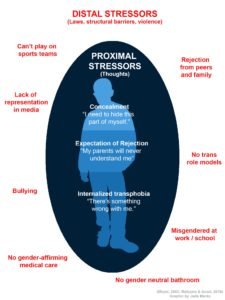When Possible, Choose Joy over Grief
Many parents experience a period of grief, sadness, or shock when adjusting to their child’s gender disclosure. This may be related to hopes or expectations that parents formed about who their child would be; which may extend beyond their gender. Similarly, we often expect our children to participate in specific activities, achieve certain grades, or pursue a particular career. While these emotional reactions are common, they can be effectively processed alone, with one’s co-parent or partner, with one’s therapist, friends or other sources of social support, and not their transgender nonbinary (TGNB) child. These reactions can be emotionally burdensome to children who may internalize negative reactions from their parents as evidence of their own failures or rejections of their identities. Research indicates familial support, more than any other source of support, as the number one protective factor against suicidal ideation and attempts (Travers et al, 2012; Matsuno & Israel, 2018).
Once the grief is less pressing, you may have more emotional capacity to join in on the joy. How many new moments of connection might you enjoy with your child once you can celebrate their gender? How many might you miss during a period of non-acceptance?
In the spirit of dialectics, I believe we are all doing the best we can to support our TGNB friends and relatives, and we all need to try harder, do better and show up more for our TGNB loved ones. These include the people in your life that might not even be out to you as TGNB. (There are at least 1.4 million of us in the U.S. alone) (Flores, Herman, Gates & Brown, 2016; Wilson & Meyer, 2021). The tips below are here to help you show up in a validating way.
10 Tips for How to Show Up for Your Transgender / Nonbinary (TGNB) Family Member
1. Use their pronouns and chosen name. There are many ways to “transition:” medically, legally, and socially. Not everyone has the option or interest in transitioning medically, so correctly acknowledging social aspects of people’s gender may be even more important as a means of communicating your support.
2. Get them a gift with their chosen name or initials on it (a cup, a key chain) and tell them you love the name they chose. These are great ways to celebrate this step with them.
3. If you’re not sure what pronouns to use for someone, ask! “What pronouns should I use for you?” is not an offensive question. However, refusing to use someone’s pronouns communicates that their gender is not valid or you don’t perceive them as they experience themselves. Misinterpreting and ignoring are forms of traumatic invalidation (Harned, 2022).
■ Challenge question: Can you remember the last time someone misunderstood or ignored something about you that is fundamental to your self-concept? How did this affect your subsequent interactions? 4. Practice, practice, practice! Practice pronouns with this free (and addicting!) online game. Practice using they/them pronouns with your pets, your friends, yourself, or practice when you are talking about the TGNB person when they are not in the room.
5. Don’t give up. What happens when I mess up? It’s ok! And, keep trying to do better. Forgive yourself internally, acknowledge the mistake briefly, and move on with the conversation. Mistakes happen, especially when we’re learning something new. Dwelling on this moment by apologizing multiple times or trying to explain how it happened is generally more overwhelming to the person who has been misgendered.
○ “She, I mean he, loves skateboarding. My bad. Where should we go for lunch?”
6. Get outside support. Tap your community, including online support threads (linked below) for advice and resources. It’s okay to be struggling, and it’s best to process your challenging emotions away from your trans or nonbinary child.
7. Familiarize yourself with trans culture, media, and narratives. Who does your child look up to and why? Celebrate their role model’s successes and keep an eye out for potential mentors to hire for additional support.
8. Diversify your sources of information. Direct your questions and research to trans-led organizations and doctors who are trans and/or have extensive experience working with TGNB individuals.
9. Practice radical acceptance. In order to avoid intentional or inadvertent rejection of their gender-diverse children, parents can practice the DBT skill of radical acceptance of both their emotional reactions and their child’s gender.
10. Be intentional about your observations, comments, and questions. The following is a table of common TGNB microaggressions. A microaggression is a seemingly inconsequential comment or action that is invalidating or hurtful. These are usually accidental and have a significant negative impact, especially cumulatively and over time. The negative impact on the person receiving the comment is often unknown to the person who committed the microaggression (Sue & Spanierman, 2020).
| Common Microaggression | Example & Affirming Replacement | Rationale |
| Misgendering |
“Charlie was born as a girl and now is a boy.” → “Charlie is a boy.”
If you must reference someone’s assigned sex at birth and you have their consent to share this information: → “Charlie was assigned female at birth.” |
Comments about who a person “used to” be can be invalidating because people are often aware of their gender before coming out to others about it – the fear of rejection might have kept them from disclosing widely. It’s best practice to retroactively refer to people with the pronouns and gender they currently identify with. |
|
Unwanted body commentary |
“You used to have such nice (body-related comment)” “But you’re such an attractive/beautiful/handsome girl/boy!” → “I love who you are becoming.” → “Let’s go shopping for some new clothes!” → “What words would you like me to use to refer to you? (handsome, beautiful, intelligent…)” |
Comments about someone’s physical appearance, body, or attractiveness in regards to their assigned gender can be really hurtful to TGNB people. When uncertain, always frame compliments or observations in the context of their present sense of gender. |
|
Dismissing / controlling transition-related goals |
“I’m scared that you’re going to want surgery/hormones.” “I’ll support you as long as you don’t medically transition.”
→ “If you feel open to sharing, what are your goals for transition? → “How can I support you?” → “What do you like to receive affirmation about?” → “What gives you gender euphoria?” |
Not everybody wants to medically transition, and people’s gender related goals are personal and change over time. It’s important to ask questions about medical transition with sensitivity and an openness to not receive an answer. They might not be ready to share details about their body, goals for transition or current gender affirmation processes. Depending on your relationship (sibling, parent, etc.) certain questions may be more or less appropriate. |
| Projecting fears |
“I feel sad/worried for you” “You must feel trapped in your body.” “I’m scared of how people will treat you.” → “I’m so proud of you.” → “I’m going to be right by your side through this process.” → “I have some questions, and I’m going to do research on my own.” |
While there are higher risks of distress and negative psychosocial outcomes associated with being TGNB, these risks come from social stigma, invalidation, and barriers to resources, not from one’s gender identity! Instead of sharing your concern for their anticipated difficulties, decide to be an ally and ask how you can support them. |
| Ageism |
“You’re too young – you won’t know what’s real or best for you until you’re older.” “You’re too old – if this were real, you would have known about it since you were a child.” → “I’m honored you decided to share this with me. It’s never too late/too early to come out as trans.” → “I believe you, let’s get more information together about potential options for affirming your gender.” → “Thank you for telling me, that was really brave. I’m excited to get to know more about you and who you’re becoming. |
TGNB people are told they are either “too young” or “too old” to be trans quite often. This shows that ageism exists across the spectrum of transness. There is no “right” age when we “truly know” what our gender is. At the same time, our readiness to make decisions about which gender affirming steps to take may shift depending on a number of factors, including our age. Regardless of these decisions and readiness factors, validation and support are necessary every step of the way. |
Additional Resources
APA: Singular “They” Is Grammatically Correct
Practice pronouns with this free online game
Gender-affirming tele-health care Counseling groups for TGNB youth/parents
Sylvia Rivera Project & Lambda Legal – Trans legal collective and legislative support
References
Flores, A.R., Herman, J.L., Gates, G.J., & Brown, T.N.T. (2016). How many adults identify as transgender in the United States? Los Angeles, CA: The Williams Institute
Harned, M. S. (2022). Treating trauma in dialectical behavioral therapy: The DBT prolonged exposure protocol. The Guilford Press.
Matsuno, E. & Israel, T. (2018). Psychological interventions promoting resilience among transgender individuals: Transgender resilience intervention model (TRIM). The Counseling Psychologist, 46(5), 632-655.
Olson, K.R., Durwood, L., DeMeules, M. & McLaughlin, K.A. (2016). Mental health of transgender children who are supported in their identities. Pediatrics, 137(3), 1-8.
Sue, D. W., & Spanierman, L. B. (2020). (2nd ed.). John Wiley & Sons, Inc.
Travers, R., Bauer, G., Pyne, J., Bradley, K., Gale, L., & Papadimitriou, M. (2012). Impacts of strong parental support for trans youth: A report prepared for Children’s Aid Society of Toronto and Delisle Youth Services. Retrieved from http://transpulseproject.ca/wp-content/uploads/2012/10/Impacts-of-Strong- Parental-Support-for-Trans-Youth-vFINAL.pdf
Wilson, B. D. M. & Meyer, I. H. (2021). Nonbinary LGBTQ adults in the United States. Los Angeles: The Williams Institute.









 pretending that a spatula is a paddle they can use to row down a river? Grab some tongs and start paddling too! There’s a reason they say imitation is the sincerest form of flattery.
pretending that a spatula is a paddle they can use to row down a river? Grab some tongs and start paddling too! There’s a reason they say imitation is the sincerest form of flattery.


